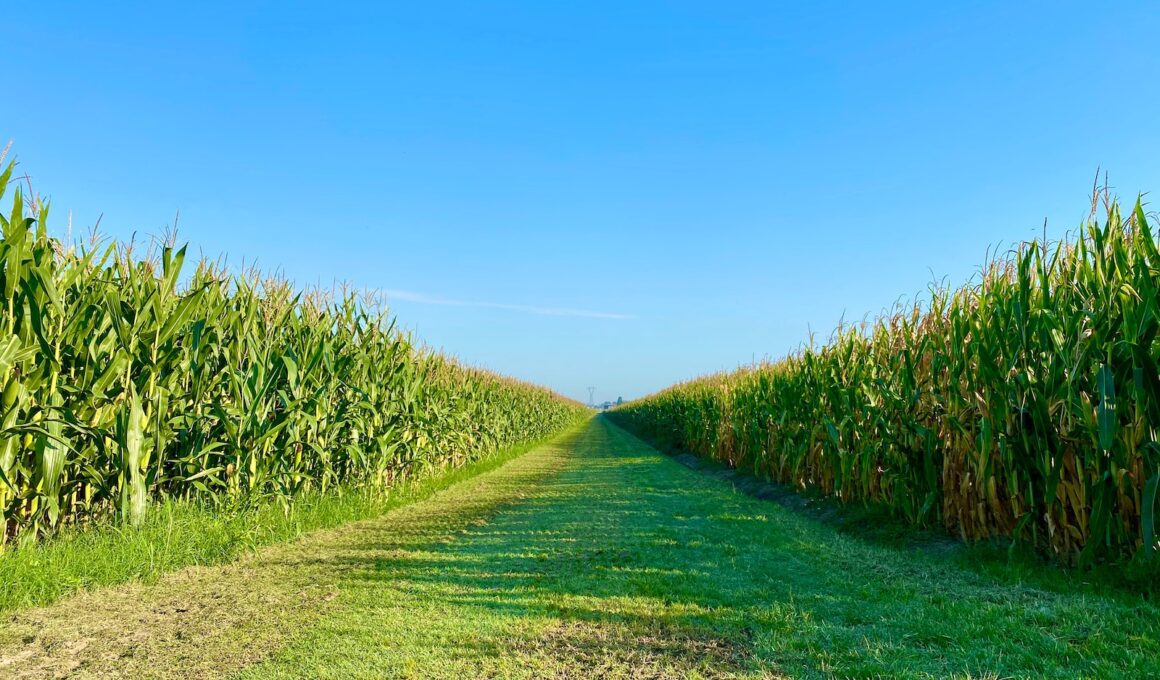Quick Takeaways
- Working organic matter into the soil improves soil health and feeds corn plants.
- Spreading a 2-3 inch layer of compost or aged manure improves soil structure and nutrient retention.
- Creating planting rows with enough space for each corn seed is important, with rows about 30 inches apart and holes spaced about 12 inches apart.
- Proper pest control measures should be taken to protect corn crops, including identifying pests, seeking advice from local farmers or agricultural professionals, practicing crop rotation, and using natural predators.
Choosing the Ideal Location
You’ve gotta pick the perfect spot for your corn because believe it or not, location’s everything when it comes to growing some killer kernels! Make sure you’re choosing a place that gets plenty of sunshine. Corn loves the sun and needs at least six hours of it each day. Also, try to find a flat area. Hills can cause water to run off too quickly and not reach your corn’s roots. Now let’s talk about soil. It’s super important for your corn’s growth. The best soil is rich in nutrients and isn’t too sandy or full of clay. If you give it a squeeze and it sticks together but breaks apart easily when you poke it, you’re onto a winner! This type of soil will hold just enough water for your corn without drowning them or drying out too fast. Don’t forget about wind protection either! Cornstalks are tall and skinny which means they can be knocked over by strong gusts of wind easily. Try planting near buildings, fences, or rows of trees if possible – these should help act as buffers against the wind while still allowing enough sunlight through for your plants. And remember: safety first! You wouldn’t want anyone getting hurt from falling stalks now would we? So keep an eye on weather forecasts and take any necessary precautions to ensure everyone stays safe around your growing corn field.Testing the Soil Quality
Before anything else, it’s essential to test the soil quality in your plot, as this will significantly impact the growth and yield of your crops. You see, corn loves rich, well-drained soil with a pH level between 6.0 and 7.0. Not sure what a pH level is? Well, it’s simply a measure of how acidic or alkaline your soil is. So testing the soil helps you know if you need to add certain things to make it just right for your corn. Now let’s talk about how you can test your soil. You can purchase an easy-to-use home testing kit from any garden supply store or online. These kits usually come with instructions, so don’t worry if you’ve never done this before! Simply follow the steps in the guide – take a bit of soil from different parts of your field, mix them together, and then use the provided tools to check its pH level and nutrient content. So now that you’re equipped with this knowledge on how crucial good quality soil is for growing corn and how easy it is to test it yourself at home, go ahead! Don’t shy away from getting those hands dirty because remember – healthy soil equals healthy crops, which leads to a safe harvest season without worries over crop failure or poor yields. And isn’t that what we all want? A bumper crop without any worries hanging over our heads? So get out there and start preparing for that successful corn planting today!Adjusting the pH Levels
So, let’s dive right in and discuss how to adjust those pesky pH levels in your soil – trust me, it’s not as intimidating as it sounds! Picture this: Soil is like a big dinner table for your corn. The meal being served? Nutrients. But corn plants are picky eaters – they prefer their food (or nutrients) served at a specific pH level. That’s just fancy talk for how acidic or alkaline the soil is. You want to aim for a pH level between 5.8 and 7.0; that’s where corn thrives best. Now, you might be wondering how you can change the pH of your soil if it’s not within this range. Don’t sweat it! It all comes down to adding certain things into the mix. If your soil has too much acid (a low pH), lime will be your new best friend – adding lime raises the pH making it more alkaline or ‘sweet.’ On the flip side, if you have overly alkaline soil (a high pH), add some sulfur or peat moss to lower that number and make things more on the ‘sour’ side. Remember, safety first when handling these amendments – use gloves and follow package instructions carefully! And here’s something else: changes won’t happen overnight, so patience is key here folks! Keep checking those levels over time and continue adjusting as needed until you hit that sweet spot between 5.8 and 7.0 where your corn will be ready to grow happily ever after.Nutrient Enrichment for Soil
After adjusting those pH levels just right, let’s turn our attention to the next star of the show: enriching your soil with nutrients! Your corn crops need good food to grow strong and healthy. Think of it this way, if you only eat junk food, you won’t feel your best, right? It’s the same for plants. Without the right nutrients in the soil, they can’t grow properly. Now, there are three main players when it comes to soil nutrients: nitrogen (N), phosphorus (P), and potassium (K). These big guys are often called N-P-K and they’re super important for plant growth. Nitrogen helps with leaf growth while phosphorus is all about root development and flowering. Potassium keeps everything running smoothly inside the plant. You can add these nutrients to your soil by using fertilizers. Just make sure you follow the instructions on how much fertilizer to use because too much of a good thing can be bad. I know we’ve covered a lot today but hang in there! Remember: enriching your soil isn’t something that happens overnight – it takes time and patience. It might seem like a lot of work at first but trust me, once you see those healthy corn stalks growing tall in your field, you’ll realize it was all worth it! So go ahead; give that soil some love – after all, safety doesn’t happen by accident but through careful nurturing and preparation!Clearing the Land
Clearing the land is a labor of love, folks – it’s all about creating a clean slate where your dreams can take root. It’s not just about removing rocks, weeds and other unwanted stuff from your field. Nope, it also means leveling off any bumps or dips so that your corn plants will grow evenly. This may sound like hard work, but don’t worry! With some patience and elbow grease, you’ll have that field ready in no time. Here are some steps to help you clear out your field:- Trimming: Start by trimming any large shrubs or trees that might steal sunlight from your future corn plants.
- Weed Control: Use a hoe or tiller to get rid of those pesky weeds. Remember to pull them out roots and all!
- Levelling: Next comes leveling the ground. You can do this with a good old-fashioned rake.
- Debris Removal: Last but not least, remove any rocks or debris left on the field.
Breaking Up the Soil
Breaking up the soil is crucial, folks – you can’t just plop your seeds onto a hard, compact ground and expect them to thrive. You’ve got to give those little kernels room to breathe and grow! Imagine trying to push through a rock-hard surface – it’s near impossible. It’s the same for your corn seeds. If they’re stuck in tight soil, they won’t be able to sprout strong roots or reach for the sun. Now, how do you go about breaking up your field? Use what’s called a tiller or cultivator. This handy tool chews up the ground, making it soft and loose. Start by running it over your field in long straight rows, then cross over those lines at a right angle. This crisscross pattern ensures every inch of land gets loosened properly. Remember to wear safety gear while doing this – goggles and gloves are must-haves! When you’re done tilling, take some time to admire your work – a nicely broken-up field ready for planting! But before you start dropping in those seeds, there’s another step – adding compost or organic matter into the mix. Working this into the soil will feed your plants as they grow, keeping them healthy and safe from disease. With that done correctly, you’ll have set yourself up for success – an abundant harvest of juicy corn awaits you!Incorporating Organic Matter
Now, let’s dive into the world of organic matter and its crucial role in nurturing your future crop. Adding organic matter to your field is like giving it a healthy meal packed with vitamins and nutrients. This makes the soil healthier, meaning your corn will be healthier too! You can use compost or aged manure for this purpose; just make sure they’re well-rotted so they won’t harm your plants. Adding organic matter to your field isn’t tough. Start by spreading a 2-3 inch layer of compost or manure over your field. Then, mix it into the soil using a shovel or rototiller. It’s like stirring sugar into coffee – you want to make sure it’s evenly spread throughout! This process helps improve soil structure and boosts its ability to hold water and nutrients. So there you have it! A simple but essential step in preparing your field for planting corn: incorporating organic matter. Remember, good soil is the foundation of a bountiful harvest. So take care of it, nourish it with rich organic material, and watch as your crops flourish under their safe haven.Creating Planting Rows
After you’ve mixed in that organic goodness, it’s time to envision your future corn kingdom and start creating neat rows for your seeds. You want to make sure each seed has enough space to grow into a strong, healthy plant. Pick up a long stick or a garden hoe, and start making straight lines in the soil. Each line should be about 30 inches apart from the next. This gives the corn plenty of room to sprout without crowding their neighbors. Now, you need to make little homes for your seeds in these rows. Using either your finger or a small tool, poke holes about one inch deep into the soil along each row. The holes should be spaced out by about 12 inches from each other. It might seem like a lot of space but remember, plants are like people – they don’t like feeling cramped! Giving them room lets them stretch their roots out wide and deep into the nutritious earth you’ve prepared. You’re doing great! Just one last thing before we wrap this up: covering those seeds snugly with soil is very important for their safety and growth. Gently push some dirt over each hole where you planted a seed until it’s completely hidden from view. That’s it! You’ve just created safe homes for your corn seeds where they can grow big and strong without stress or danger from overcrowding or exposure on top of the ground.Can Bagging Potatoes Improve Their Growth and Taste?
Bagging potatoes for easy cooking has been a popular technique among gardeners. This method not only enhances convenience in the kitchen but also offers potential benefits for growth and taste. By protecting the potatoes from sunlight, bagging helps prevent greening, resulting in a better taste. Additionally, it creates a controlled environment that encourages healthier growth, yielding more robust and flavorful spuds.
Soil Moisture Control
Maintaining the right level of moisture in your soil is crucial to ensure your seeds sprout into thriving plants. Think of it like this: too much water can make the seeds rot, while too little can leave them thirsty and unable to grow. Your goal is to find a healthy balance. It’s just like when you’re thirsty – not enough water and you feel tired, too much and you feel sick. Let’s see how you can achieve that balance for your corn crop. Start by watering your field thoroughly before planting the seeds. But be careful! You don’t want puddles of water everywhere; if you see any, that means there’s way too much water. After planting, keep an eye on the soil. If it looks dry or crusty, it might need more water. Remember, every field is different – what works for one may not work for another because each has its own unique needs. The trick here is to pay attention to your field and respond accordingly: if the soil feels dry or hard underfoot, give it a good soak; if it feels soggy or spongy, hold back on the watering until things balance out again. This way, no matter what Mother Nature throws at you during the growing season – whether she decides to be stingy or generous with rainfall – you’ll know exactly how to keep your corn plants safe and satisfied with just the right amount of water they need to grow big and strong!What are the best methods for preparing a field for growing turmeric?
To successfully grow turmeric at home, the best methods for preparing a field include loosening the soil to a depth of at least 8 inches, adding organic compost, and ensuring the area receives plenty of sunlight. It’s also important to control weeds and pests to promote healthy turmeric growth.









